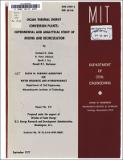Ocean Thermal Energy Conversion Plants: Experimental and Analytical Study of Mixing and Recirculation
Author(s)
Jirka, Gerhard H.; Johnson, R. Peter; Fry, David J.; Harleman, Donald R. F.
Download04218399.pdf (7.301Mb)
Metadata
Show full item recordAbstract
Ocean thermal energy conversion (OTEC) is a method of generating power using the vertical temperature gradient of the tropical ocean as an energy source. Experimental and analytical studies have been carried out to determine the characteristics of the temperature and velocity fields induced in the surrounding ocean by the operation of an OTEC plant. The condition of recirculation, i.e. the re-entering of mixed discharge water back into the plant intake, was of particular interest because of its adverse effect on plant efficiency. The studies were directed at the mixed discharge concept, in which the evaporator and condenser water flows are exhausted jointly at the approximate level of the ambient ocean thermocline. The OTEC plant was of the symmetric spar-buoy type with radial or separate discharge configurations. A distinctly stratified ocean with uniform, ambient current velocity was assumed. The following conclusions are obtained: The recirculation potential of an OTEC plant in a stagnant ocean is determined by the interaction of the jet discharge zone and a double sink return flow (one sink being the evaporator intake, the other the jet entrainment). This process occurs in the near-field of an OTEC plant up to a distance of about three times the ocean mixed layer depth. The stratified internal flow beyond this zone has little effect on recirculation, as have small ocean current velocities (up to 0.10 m/s prototype). Conditions which are conducive to recirculation are characterized by high discharge velocities and large plant flow rates. A design formula is proposed which determines whether recirculation would occur or not as a function of plant design and ocean conditions. On the basis of these results, it can be concluded that a 100 MW OTEC plant with the mixed discharge mode can operate at a typical candidate ocean site without incurring any discharge recirculation.
Description
Prepared under the support of Division of Solar Energy, U.S. Energy Research and Development Administration, Contract no. EY-76-S-02-2909.M001
Date issued
1977-09Publisher
Cambridge : Ralph M. Parsons Laboratory for Water Resources and Hydrodynamics, Massachusetts Institute of Technology. Department of Civil Engineering
Other identifiers
231
Series/Report no.
R (Massachusetts Institute of Technology. Department of Civil Engineering) ; 77-38.Report (Ralph M. Parsons Laboratory for Water Resources and Hydrodynamics) ; 231.COO (Series) ; 2909-3.